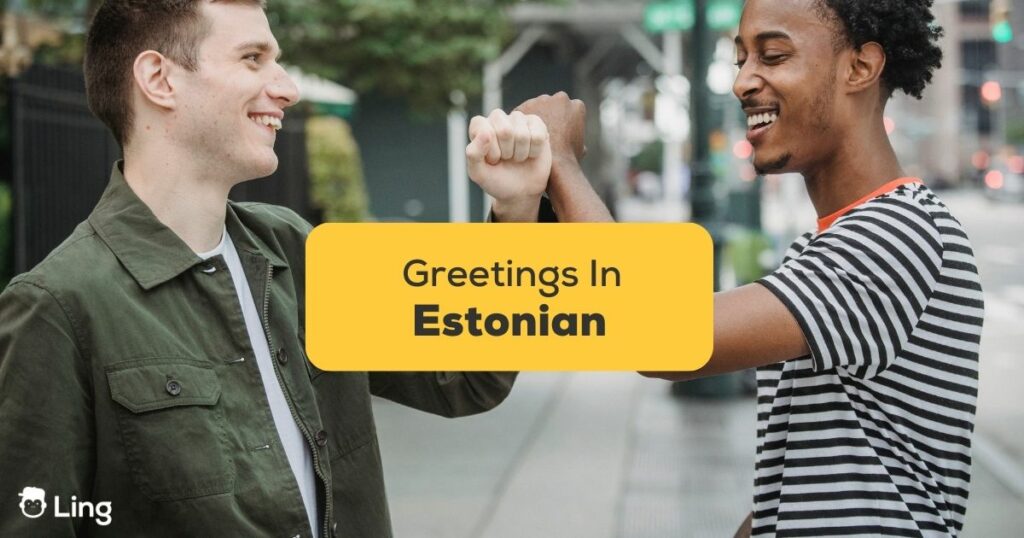Ever found yourself at a loss for words when attempting greetings in Estonian? Well, you’re in luck, because we’re about to make Estonian greetings your new favorite party trick. We’re not teaching you this for the sake of impressing strangers but also to help you break the ice when your elbow to elbow with the locals during your trip to Estonia. Ready to learn more? Keep reading below!
When I first visited Estonia, I was armed with nothing but enthusiasm and a pocket phrasebook. Excited to try out my freshly learned greetings in Estonian, I confidently walked into a local shop and attempted a cheerful “Tere päevast!” (Good afternoon!). What came out, however, was more of a tongue-twisted mishmash that left the shopkeeper both bemused and slightly concerned.
My mouth seemed to have a mind of its own, jumbling the sounds and turning a simple greeting into a linguistic puzzle!
I found myself red-faced, laughing at my own blunder, while the friendly Estonian simply smiled and responded with a patient “Tere.” It was a humbling, hilarious reminder that sometimes, even the simplest words can turn into an adventure of their own in a new language! And so if you don’t want to experience that, then learning even the most common informal greetings will help you out! So without further ado, let’s start learning below!

Greetings In Estonian
You know how sometimes life just speeds by, and we forget to say a proper hello? (Sounds super dramatic, I know😂) Well, not in Estonia, my friend! The locals are just very warm to foreigners, so I know for a fact that mastering those greetings is like hitting the pause button and giving a high-five to the person you’re talking to. It’s more than just being polite; it’s about grooving with the day’s vibe. In this section, let’s go over the various greetings in Estonian for the time of day:
- “Tere hommikust!” (Good morning!) – A cheery greeting to kickstart the day, this is what you’ll likely say when you bump into someone in the early hours. The sun is shining, the coffee is brewing, and a friendly “Tere hommikust!” sets the mood just right.
- “Tere päevast!” (Good afternoon!) – As the day progresses and the morning hustle settles into a comfortable pace, this greeting takes over. It’s a sign that you’re in tune with the day’s flow, acknowledging the shift from morning’s freshness to afternoon’s calm.
- “Tere õhtust!” (Good evening!) – As the skies dim and the evening sets in, this greeting ushers in the quieter, reflective part of the day. Whether it’s a neighbor you meet in the elevator or a colleague you’re leaving behind at the office, “Tere õhtust!” is a gentle nod to the day’s closure.
Pro tip: The three expressions we shared above are perfect for formal greetings and if you want to sound super polite. However, you may also consider removing the word “Tere” from those if you’re after a more casual vibe and when you’re speaking with younger people.

Gestures And Body Language When Greeting
In Estonia, verbal greetings are just one part of the equation. The way you wave, smile, shake hands, or even maintain eye contact paints a vivid picture of your intentions and feelings. Here’s a closer look at the physical dance that accompanies greetings in Estonian:
- Handshakes – In business or formal settings, a firm handshake is standard. It conveys confidence and respect. Remember to maintain eye contact and offer a gentle smile to complete the picture of sincerity. A handshake that’s too brief can seem insincere, while one that lingers too long may feel awkward. Finding the right balance is key.
- Nods and smiles – Sometimes, a nod is all it takes to acknowledge someone, especially if you’re passing a neighbor or a casual acquaintance. It’s a low-key yet warm way to say hello without words. In Estonia, a genuine smile is a welcoming sign. It’s not about beaming ear-to-ear but offering a warm, authentic expression that says you’re approachable and friendly.
- Personal space and proximity – Estonians generally value personal space. So, even in a casual greeting, it’s good to be mindful of not getting too close unless you share a more intimate relationship with the person. Hugs and kisses on the cheek are less common, especially with strangers or casual acquaintances. It’s best to follow the lead of your Estonian counterpart in these matters.
- Eye contact – A healthy dose of eye contact during a greeting indicates interest and sincerity. But remember, there’s a fine line between engaging eye contact and an uncomfortable stare. Feel the moment and act accordingly.
- Waving – Whether you’re saying hello to a friend across the street or bidding goodbye to a fellow traveler, a friendly wave is a universally recognized sign of greeting in Estonia. It’s casual, non-intrusive, and filled with good vibes.
So, gestures and body language in Estonia? Think of them as the cool doodles and sketches that jazz up a plain ol’ chat. They’re like the secret sauce that gives your talk time some serious flair and style. Want to make friends, impress the locals, or just fit in? Get these moves down, and you’re not just saying ‘hi’; you’re giving a high-five to the Estonian way of life. How cool is that?
Learn Estonian With Ling
Alright, so you’ve got the hang of the whole greetings game in Estonian, right? From those slick words to those cool hand gestures, you’re in the groove. But hey, why put on the brakes? Estonian isn’t just a bunch of sounds and syllables; it’s like this awesome jam that you can dance to. You think greeting people in Estonian is fun? Trust me, there’s a whole party of language waiting for you to join in. Let’s keep the rhythm going with Ling!
Whether you’re aiming for casual conversational fluency or striving for a more profound linguistic mastery, platforms like these offer a flexible, engaging way to learn Estonian at your own pace. Give it a try now by downloading it for FREE from the App Store or Play Store now.


































































